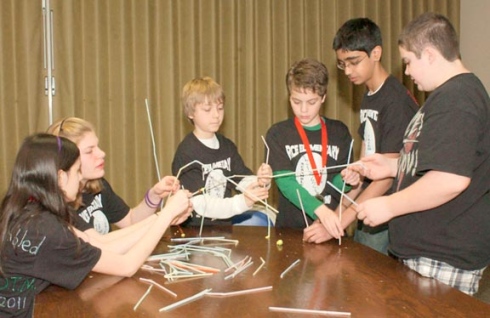Spontaneous is half of the competitive score and is often what makes or breaks a team. It is also one of the most difficult aspects of Odyssey of the Mind to describe. Spontaneous is, as it sounds, on the spot creativity. It is about how teams can solve a problem that they were given minutes before they need to present a solution. In terms of actual creativity, spontaneous is probably the most indicative of the two parts of OM. It shows whether or not team members are creative without much forethought on how to make answers more creative. It is also the most difficult aspect to prepare for. You can do practice problems to get into the mindset of thinking creatively, but you can never know what the problem at competition will be, or even what kind of problem you will have. There are three main kinds of spontaneous problems: verbal, hands on, and verbal-hands on. There are other types of spontaneous problems, but they exist mostly in legend from when they befuddled OMers of the past.
When teams get ready to go to spontaneous, they choose, or have already chosen, five members who will compete. The remaining members can either sit outside of the room while the others compete or they can sit inside but not participate. At every competition, each team goes into a spontaneous room dependent on age and problem one at a time. Then, they are read a problem and they must give a solution or multiple solutions within a set amount of time.
Verbal
Verbal spontaneous problems are generally the shortest of all problems. The entire problem, from the reading of the problem to when the team leaves, rarely lasts longer than 10 or 15 minutes. This also makes verbal spontaneous problems some of the most nerve-wracking for many OMers. Verbal problems ask each of the five chosen members to give either as many as possible or up to a set amount of responses within the given time. Each response is scored on its creativity [8]. Responses are all given verbally, hence the name. The problems for this type are often things like: "Name different types of bears" or "Give an excuse for why you couldn't go to school". The questions often seem simple, but they challenge OMers to think about the questions in different ways and twist the meanings to fit their fancy.
Hands On
Hands on Spontaneous problems generally take the most time. A hands on problem is characterized by team members being required to build something or to use materials to solve a problem rather than to respond to a problem [3]. Typical hands on problems are things like: "Build a bridge with the given materials from one area to another" or "Use the materials to signal team members to complete the given task". The goal of these problems is to find a loop-hole to make the best solution.
Verbal-Hands On
Verbal-hands on, as expected, is a combination of the above two types. Team members are asked to create something using given materials, and then they have to give responses based on what they have built. For example: "Build a creature out of the given materials. Then create a story using the character". The most important thing about these problems is to create something that is creative enough to harbor lots of good responses.

